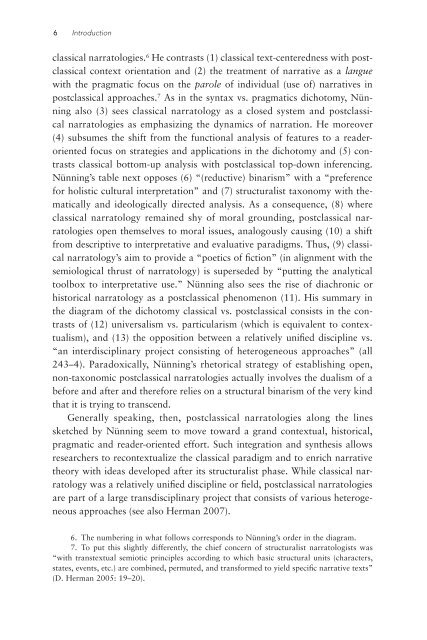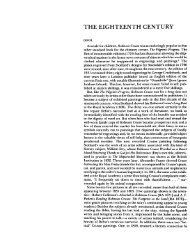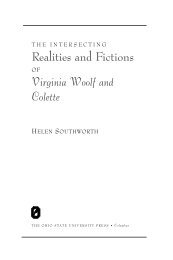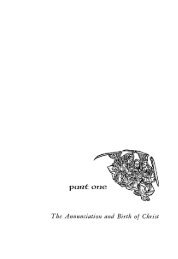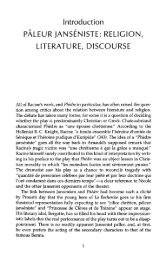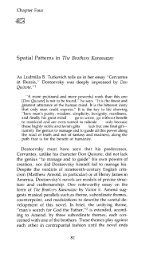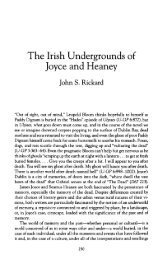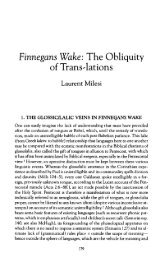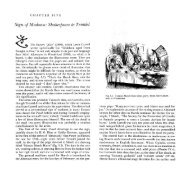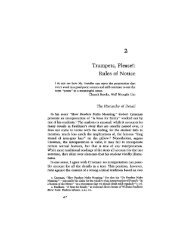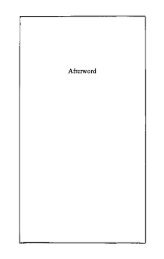Postclassical Narratology: Approaches and Analyses
Postclassical Narratology: Approaches and Analyses
Postclassical Narratology: Approaches and Analyses
You also want an ePaper? Increase the reach of your titles
YUMPU automatically turns print PDFs into web optimized ePapers that Google loves.
6 Introduction<br />
classical narratologies. 6 He contrasts (1) classical text-centeredness with postclassical<br />
context orientation <strong>and</strong> (2) the treatment of narrative as a langue<br />
with the pragmatic focus on the parole of individual (use of) narratives in<br />
postclassical approaches. 7 As in the syntax vs. pragmatics dichotomy, Nünning<br />
also (3) sees classical narratology as a closed system <strong>and</strong> postclassical<br />
narratologies as emphasizing the dynamics of narration. He moreover<br />
(4) subsumes the shift from the functional analysis of features to a readeroriented<br />
focus on strategies <strong>and</strong> applications in the dichotomy <strong>and</strong> (5) contrasts<br />
classical bottom-up analysis with postclassical top-down inferencing.<br />
Nünning’s table next opposes (6) “(reductive) binarism” with a “preference<br />
for holistic cultural interpretation” <strong>and</strong> (7) structuralist taxonomy with thematically<br />
<strong>and</strong> ideologically directed analysis. As a consequence, (8) where<br />
classical narratology remained shy of moral grounding, postclassical narratologies<br />
open themselves to moral issues, analogously causing (10) a shift<br />
from descriptive to interpretative <strong>and</strong> evaluative paradigms. Thus, (9) classical<br />
narratology’s aim to provide a “poetics of fiction” (in alignment with the<br />
semiological thrust of narratology) is superseded by “putting the analytical<br />
toolbox to interpretative use.” Nünning also sees the rise of diachronic or<br />
historical narratology as a postclassical phenomenon (11). His summary in<br />
the diagram of the dichotomy classical vs. postclassical consists in the contrasts<br />
of (12) universalism vs. particularism (which is equivalent to contextualism),<br />
<strong>and</strong> (13) the opposition between a relatively unified discipline vs.<br />
“an interdisciplinary project consisting of heterogeneous approaches” (all<br />
243–4). Paradoxically, Nünning’s rhetorical strategy of establishing open,<br />
non-taxonomic postclassical narratologies actually involves the dualism of a<br />
before <strong>and</strong> after <strong>and</strong> therefore relies on a structural binarism of the very kind<br />
that it is trying to transcend.<br />
Generally speaking, then, postclassical narratologies along the lines<br />
sketched by Nünning seem to move toward a gr<strong>and</strong> contextual, historical,<br />
pragmatic <strong>and</strong> reader-oriented effort. Such integration <strong>and</strong> synthesis allows<br />
researchers to recontextualize the classical paradigm <strong>and</strong> to enrich narrative<br />
theory with ideas developed after its structuralist phase. While classical narratology<br />
was a relatively unified discipline or field, postclassical narratologies<br />
are part of a large transdisciplinary project that consists of various heterogeneous<br />
approaches (see also Herman 2007).<br />
6. The numbering in what follows corresponds to Nünning’s order in the diagram.<br />
7. To put this slightly differently, the chief concern of structuralist narratologists was<br />
“with transtextual semiotic principles according to which basic structural units (characters,<br />
states, events, etc.) are combined, permuted, <strong>and</strong> transformed to yield specific narrative texts”<br />
(D. Herman 2005: 19–20).


